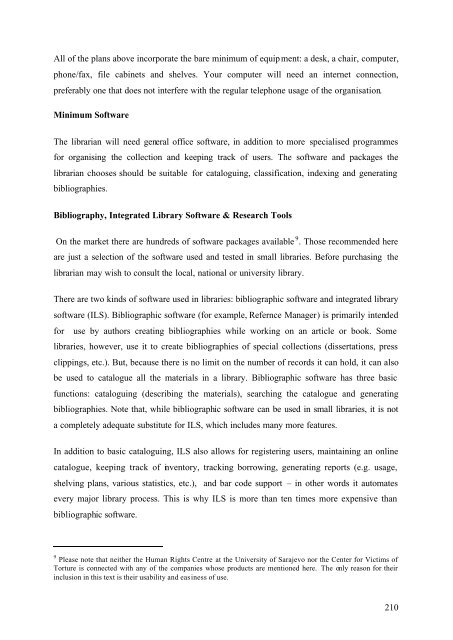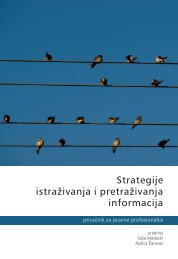Winds of Change - Centar za ljudska prava Univerziteta u Sarajevu ...
Winds of Change - Centar za ljudska prava Univerziteta u Sarajevu ...
Winds of Change - Centar za ljudska prava Univerziteta u Sarajevu ...
You also want an ePaper? Increase the reach of your titles
YUMPU automatically turns print PDFs into web optimized ePapers that Google loves.
All <strong>of</strong> the plans above incorporate the bare minimum <strong>of</strong> equipment: a desk, a chair, computer,<br />
phone/fax, file cabinets and shelves. Your computer will need an internet connection,<br />
preferably one that does not interfere with the regular telephone usage <strong>of</strong> the organisation.<br />
Minimum S<strong>of</strong>tware<br />
The librarian will need general <strong>of</strong>fice s<strong>of</strong>tware, in addition to more specialised programmes<br />
for organising the collection and keeping track <strong>of</strong> users. The s<strong>of</strong>tware and packages the<br />
librarian chooses should be suitable for cataloguing, classification, indexing and generating<br />
bibliographies.<br />
Bibliography, Integrated Library S<strong>of</strong>tware & Research Tools<br />
On the market there are hundreds <strong>of</strong> s<strong>of</strong>tware packages available 9 . Those recommended here<br />
are just a selection <strong>of</strong> the s<strong>of</strong>tware used and tested in small libraries. Before purchasing the<br />
librarian may wish to consult the local, national or university library.<br />
There are two kinds <strong>of</strong> s<strong>of</strong>tware used in libraries: bibliographic s<strong>of</strong>tware and integrated library<br />
s<strong>of</strong>tware (ILS). Bibliographic s<strong>of</strong>tware (for example, Refernce Manager) is primarily intended<br />
for use by authors creating bibliographies while working on an article or book. Some<br />
libraries, however, use it to create bibliographies <strong>of</strong> special collections (dissertations, press<br />
clippings, etc.). But, because there is no limit on the number <strong>of</strong> records it can hold, it can also<br />
be used to catalogue all the materials in a library. Bibliographic s<strong>of</strong>tware has three basic<br />
functions: cataloguing (describing the materials), searching the catalogue and generating<br />
bibliographies. Note that, while bibliographic s<strong>of</strong>tware can be used in small libraries, it is not<br />
a completely adequate substitute for ILS, which includes many more features.<br />
In addition to basic cataloguing, ILS also allows for registering users, maintaining an online<br />
catalogue, keeping track <strong>of</strong> inventory, tracking borrowing, generating reports (e.g. usage,<br />
shelving plans, various statistics, etc.), and bar code support – in other words it automates<br />
every major library process. This is why ILS is more than ten times more expensive than<br />
bibliographic s<strong>of</strong>tware.<br />
9 Please note that neither the Human Rights Centre at the University <strong>of</strong> Sarajevo nor the Center for Victims <strong>of</strong><br />
Torture is connected with any <strong>of</strong> the companies whose products are mentioned here. The only reason for their<br />
inclusion in this text is their usability and easiness <strong>of</strong> use.<br />
210





